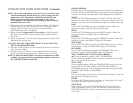
16
9. When the time has elapsed, the Display Window will show the
default time of 0:30, the Convection Oven will beep 5 times and
the ON/OFF Light will turn off as a signal that the BAKE function
is completed.
10. Using oven mitts, carefully pull the Wire Rack out and remove
cooked food.
11. Press the CLOCK Button and the Display Window will revert to
show the time of day.
12. Unplug Oven and allow to cool completely before cleaning. See
User Maintenance Instructions. Unplug when not in use.
NOTE: To adjust the BAKE time or temperature during the BAKE
process, you must start the programming sequence over. Press the
START/STOP Button and reset.
INTERNAL TEMPERATURE ROASTING CHART
CUT INTERNAL TEMPERATURE
Beef 145°F Rare
160°F Medium
170°F Well Done
Ham (fresh) 160°F
Ham (precooked) 140°F
Lamb 160°F Medium Well
170°F Well Done
Pork 160°F Medium
170°F Well Done
Turkey or Chicken, Whole 180°F
Turkey or Chicken, Breast 170°F
USDA RECOMMENDED TEMPERATURES
The United States Department of Agriculture recommends that meat
and poultry be cooked to the following internal temperatures to be sure
any harmful bacteria has been killed. Ground turkey and chicken
should be cooked to an internal temperature of 165° F and ground
beef, veal, lamb and pork be cooked to an internal temperature of
160° F. Chicken and turkey should be cooked to an internal tempera-
ture of 170° F for white meat and 180° F for dark meat. Goose and
duck should be cooked to an internal temperature of 180° F. Fresh
beef, veal and lamb, etc. should be cooked to an internal temperature
of at least 145° F. Fresh pork should be cooked to an internal tempera-
ture of at least 160° F. When re-heating meat and poultry products,
they should also be cooked to an internal temperature of 165° F.
CONVECTION OVEN FUNCTIONS (CONTINUED)
15
HINTS FOR SLOW COOK
Recipes may be used to SLOW COOK by using the following
guidelines.
• All baking dishes should be covered. Aluminum foil may be used
if ends are tucked against edge of pan.
• Ovenproof glass and ceramic dishes are recommended.
•Aluminum foil pans and pans that will rust, such as cast iron or tin
should not be used.
• Separate dishes can cook simultaneously, yet food retains its own
flavor. Select foods that will take the same amount of time to cook.
• Milk, cream and sour cream may curdle. It is best to add them in
the last hour of cooking. If a recipe specifies one of these
ingredients as the only liquid in the cooking process, try
substituting evaporated milk, water or condensed soup, such as
cream of mushroom or chicken soup.
• Slow cooking enhances the flavor of spices and salt. We
recommend you reduce seasoning in your own recipes.
• Precooked spaghetti and pasta products should be added in the
last hour of slow cooking.
PROGRAMMING THE BAKE/ROAST FUNCTION
1. Plug unit into a 120 V outlet. Close the Glass Door.
2. Press the FUNCTION Button. When the BAKE Light illuminates,
the selection is made. Press the TIME/TEMP Button until the TEMP
Light illuminates; 350
ºF appears in the Display Window.
3. To change the BAKE temperature, press the
᭡ Up ARROW for a
higher temperature (up to 450
ºF) or press the ᭢ Down ARROW for
a lower BAKE temperature (down to 100
ºF). Refer to the Roasting
Chart on the next page for recommended cooking temperatures.
4. Press the TIME/TEMP Button until the TIME Light illuminates; 0:30
(30 MINUTES) appears in the Display Window.
5. To change the BAKE time, press the
᭡ Up ARROW to extend the
time (up to 4:00 hours) or press the
᭢ Down ARROW for a shorter
BAKE time.
6. Open the Glass Door and carefully center baking dish directly on
Bake/Broil Pan or Wire Rack and close Oven Door.
7. Press the START/STOP Button. The ON/OFF Light will illuminate;
BAKE will begin; the BAKE time will appear in the Display
Window and begin to count down.
8. Convection baking will cook some foods faster. Check 5 to 10
minutes before the end of the suggested bake time. Continue
baking if necessary.


















